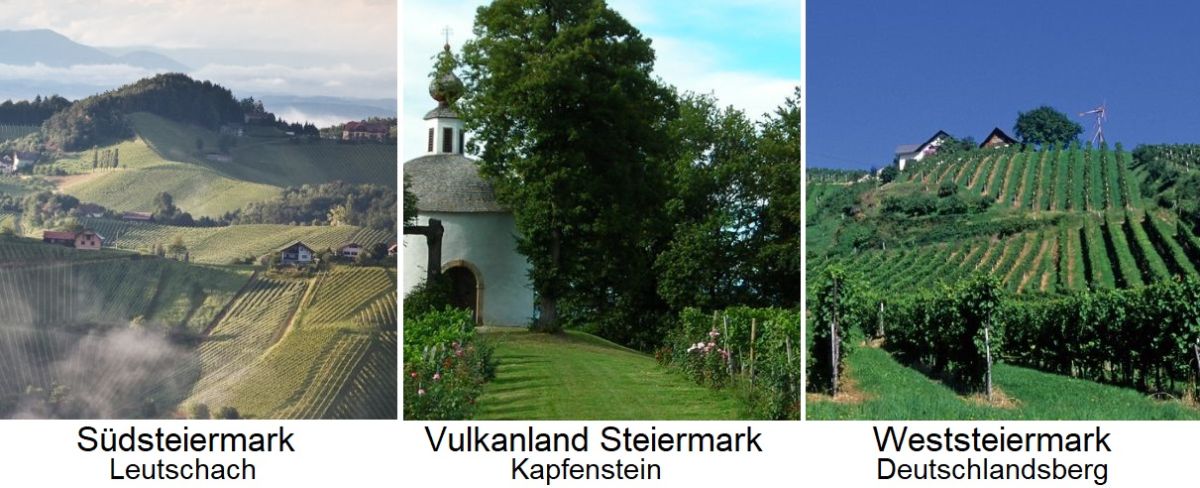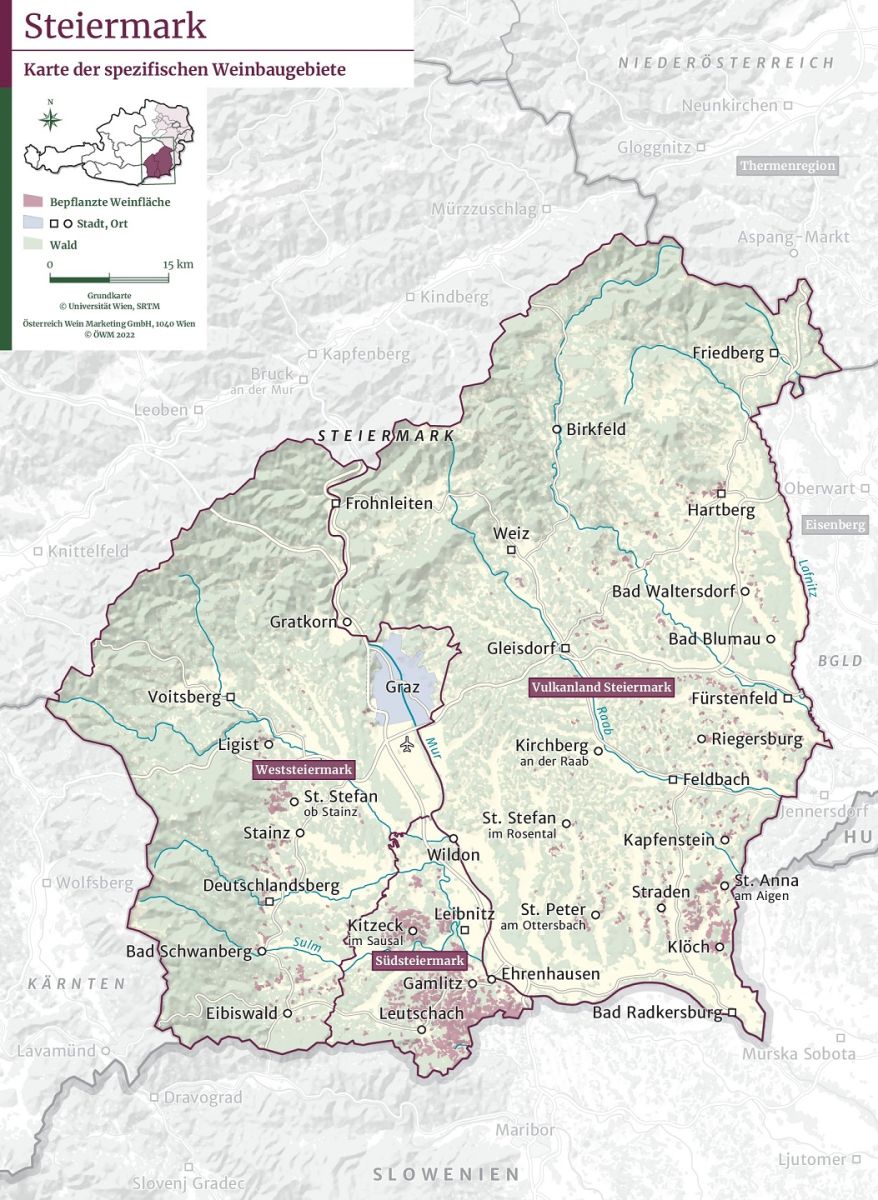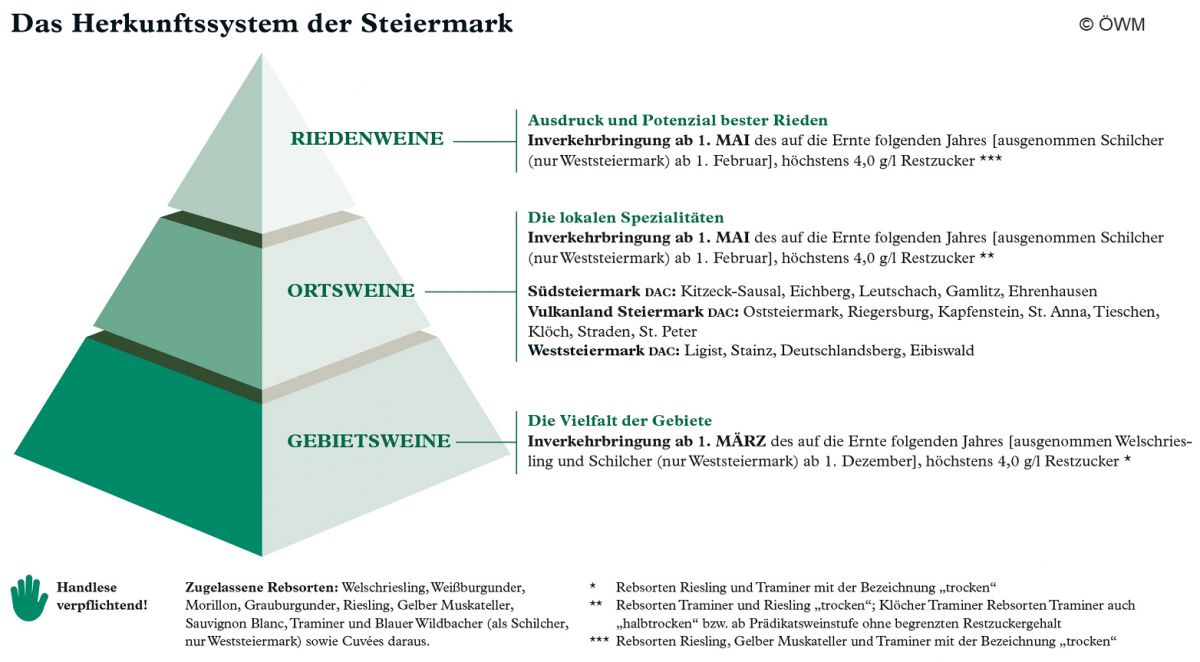Results
2,284 Results
Loading more Results ...
Loading more Results ...
Wine regions in Styria/Steiermark 7 growing regions
Description to Styria/Steiermark
The federal state of Styria with its capital Graz is located in the south-east of Austria and covers 16,400 km². It borders the federal states of Carinthia to the south-west, Salzburg (west), Upper Austria and Lower Austria to the north, Burgenland to the east and Slovenia to the south. The Celts were already cultivating vines from the fourth century BC. As in the whole of Central Europe, the Franconian Emperor Charlemagne (742-814) gave new impetus to viticulture here. In the Middle Ages, the Roman Catholic Church and its monasteries, especially Rein Abbey of the Cistercian monastic order, made great contributions to Styrian viticulture. In 1406, 535 villages with 6,000 vineyards were already documented. In the 16th century, the vineyards covered 35,000 hectares, which was around eight times as much as today. However, the Duchy of Styria was much larger than it is today and also included Lower Styria in Slovenia.

Viticulture in modern times
The Habsburg Archduke Johann (1782-1859), who is still highly revered in Styria today, owned a castle in what is now the Schilcher centre of Stainz. In 1822, he founded an experimental vineyard near Marburg, thereby setting the course for quality-orientated viticulture. The Archduke had the previously unknown local grape varieties Traminer, Sauvignon Blanc, Silvaner, Riesling and Pinot Blanc planted and trialled new forms of cultivation. He also promoted the training of winegrowers and hygiene in wine production. In 1872, the Styrian fruit and viticulture school was founded in Marburg. The first director, Hermann Goethe (1837-1911), was one of the most distinguished winegrowing experts and ampelographers of his time. Today, Styrian winegrowers are trained at the viticultural school in Silberberg near Leibnitz.
After the First World War (1914-1918), a large part of the vineyards were lost to Slovenia as a result of the Treaty of Versailles. The Second World War (1939-1945) brought great devastation, as Styria was a combat zone in many places. Viticulture suffered a decline and at the beginning of the 1960s, the area under vines totalled only around 1,600 hectares. Thanks to targeted support from the Styrian provincial government in the form of wine-growing plans with the renewal and expansion of vineyards and conversion to modern forms of cultivation, the vine population increased again by a factor of around two and a half.
Climate & soils
The climate lies at the interface of a southern European Mediterranean climate in the west and south, and a Pannonian climate with hot, low-precipitation summers in the south-east. Annual precipitation amounts to 1,200 millimetres in the west, but only 800 millimetres in the east. Large temperature fluctuations between day and night in autumn give the wines a variety of flavours. In the south-eastern area around Bad Gleichenberg, Kapfenstein, Klöch, Riegersburg and Straden, soils of volcanic origin with towering volcanic cones, sandy loams, clays and weathered basalt predominate. In Sausal there is a siliceous rocky brown earth over mica schist and gneiss. Around Fürstenfeld and north of it around Hartberg and Weiz there are weathered slate soils. In the hilly areas of Gamlitz, Glanz, Grassnitzberg, Plössnitz, Zieregg and Zoppelberg there is sandy-clayey sedimentary rock known as Opok, mixed with shell limestone.

All the vineyards are located in the south near the border with Slovenia. The vineyards are widely scattered and are mainly planted on steep southern slopes at up to 650 metres above sea level (Vulkanland Steiermark, Ringkogel near Hartberg). Around 70% of the vineyards are partly terraced slopes with a gradient of more than 26% and are therefore classified as "mountain vineyards" under Austrian wine law. The symbol of Styrian viticulture is the Klapotetz, a wind-powered device used to protect against harmful birds. The numerous wine routes are worth mentioning. Since 2018, there has also been a "Grazer Stadtwein" from revitalised vineyards on the Grazer Kehlberg. White wines, which are mostly dry and fruity, account for 75% of production. A Styrian speciality is the Schilcher made from the Blauer Wildbacher variety.
Wine-growing regions
The generic wine-growing region of Styria is divided into the three specific wine-growing regions of Südsteiermark, Vulkanland Steiermark and Weststeiermark. The DAC system was introduced in the three specific wine-growing regions in 2018. The DAC area Schilcherland, which was introduced at short notice in 2017, was replaced by DAC Weststeiermark. The generic wine-growing region of Styria must appear on the label of all quality wines; DAC wines must also bear the DAC designation. The entire area of the province forms the Steirerland wine-growing region, which serves as an indication of origin for regional wines. All other quality wines must be marketed with the origin Styria, the country wines under the wine-growing region designation Steirerland. The wine-growing regions with the development of the vineyards:

In contrast to the two federal states of Burgenland and Lower Austria (where the individual DAC areas were realised one after the other over time), an overall concept applies to all three specific wine-growing regions. There is a three-tier pyramid of origin with regional wine, local wine and Riedenwein. Styrian varietal diversity is taken into account in different ways (see diagram). In the case of regional wines, it is retained, while in the case of local wines and in some cases also Riedenwein, local leading varieties have been defined differently for each wine-growing region. Regional wines may be marketed from 1 March, single vineyard wines and local wines from 1 May of the year following the harvest. An exception is made for wines made from Welschriesling and Schilcher, which may be marketed from 1 December of the harvest year. There is also an exception for Steirischer Junker, which is traditionally presented at the beginning of November. The DAC pyramid:

Grape variety index
In 2022, the vineyards covered a total of 5,086 hectares of vines. Compared to 2016 with 4,633 hectares, this was an increase of 453 hectares (9.8%). White wine varieties account for 3,967 hectares (78%) and red wine varieties for 1,119 hectares (22%). The Styrian mixed set is a special form of mixed set. The white wine varieties are now dominated by Sauvignon Blanc, which has overtaken Welschriesling, followed by Pinot Blanc, Muscat, Chardonnay and Müller-Thurgau. Among the red wine varieties, the Styrian speciality Blauer Wildbacher dominates, followed by Zweigelt, Merlot, Blauer Burgunder and Cabernet Sauvignon. The biggest climbers were the varieties Blütenmuskateller, Chardonnay, Muscaris, Muskateller, Souvignier Gris and Weißburgunder, while the biggest decliners were Blauer Portugieser, Müller-Thurgau and St. Laurent.
Grape variety
|
in Austria
|
colour |
HA
|
%
|
HA
|
%
|
| Sauvignon Blanc | Muscat Sylvaner | white | 929 | 18,3 | 683 | 14,7 |
| Welschriesling | - | white | 773 | 15,2 | 753 | 16,2 |
| Pinot Blanc | Pinot Blanc, Klevner | white | 619 | 13,6 | 576 | 12,4 |
| Muscat | Yellow M., Red M. / Muscat Blanc | white | 549 | 10,8 | 329 | 7,1 |
| Blauer Wildbacher | - | red | 518 | 9,2 | 457 | 10,0 |
| Chardonnay | Morillon | white | 385 | 7,6 | 328 | 7,1 |
| Zweigelt | Blauer Zweigelt, Rotburger | red | 269 | 5,3 | 351 | 7,6 |
| Müller-Thurgau | Rivaner | white | 177 | 3,5 | 245 | 5,3 |
| Grey Burgundy | Pinot Gris, Ruländer | white | 156 | 3,1 | 97 | 12,1 |
| Scheurebe | Seedling 88 | white | 139 | 2,7 | 152 | 3,3 |
| White Riesling | Riesling Rhine Riesling | white | 69 | 1,3 | 63 | 1,4 |
| Traminer | Gewürztraminer, Roter T., Gelber T. | white | 66 | 1,3 | 70 | 1,5 |
| Muscaris | - | white | 52 | 1,0 | - | - |
| Souvignier Gris | - | white | 42 | 0,8 | - | - |
| Merlot | - | red | 21 | 0,4 | 21 | 0,4 |
| Pinot Noir | Pinot Noir, Pinot Noir | red | 20 | 0,4 | 18,3 | 0,4 |
| Blossom muscatel | - | white | 14 | 0,3 | - | - |
| Cabernet Sauvignon | - | red | 13 | 0,3 | 14,3 | 0,3 |
| Goldburger | - | white | 13 | 0,2 | 30 | 0,6 |
| Blue Burgundy | - | red | 11 | 0,2 | 18,2 | 0,4 |
| St Laurent | - | red | 10 | 0,2 | 13,9 | 0,3 |
| Blaufränkisch | - | red | 9 | 0,2 | 13,6 | 0,3 |
| Sylvaner | Green Sylvaner | white | 7 | 0,1 | 8,3 | 0,2 |
| Roesler | - | red | 7 | 0,1 | 6,4 | 0,1 |
| Muscat Ottonel | - | white | 5 | 0,1 | 4,4 | 0,1 |
| Grüner Veltliner | White plum | white | 4 | 0,1 | - | - |
| Gold muscatel | - | white | 4 | 0,1 | - | - |
| Syrah | Shiraz | red | 3 | 0,1 | 2,0 | - |
| Bouvier | - | white | 2 | - | 1,4 | - |
| Furmint | - | white | 2 | - | ||
| Rose muscatel | - | red | 2 | - | - | - |
| Blue Portugieser | - | red | 1 | - | 2,0 | - |
| Cabernet Franc | - | red | 1 | - | 0,8 | - |
| Rathay | - | red | 1 | - | 0,7 | - |
| Frühroter Veltliner | Malvasia | white | 0,1 | - | - | - |
| other varieties | - | white/red | 127 | 2,5 | 375 | 8,1 |
WHITE VARIETIES |
white |
3.967 |
78 |
3.594 |
77,6 |
|
RED VARIETIES |
red |
1.119 |
22 |
1.040 |
22,4 |
|
TOTAL |
|
5.086 |
|
4.633 |
|
Associations and wineries
The Styrian Wine Association represents over 750 members, other large winegrowers' associations are Steirische Terroir & Klassikweingüter and Erzherzog Johann Weine. The wineries are listed under the wine-growing regions.
Southern Styria: © ÖWM - Anna Stöcher
Vulkanland; © ÖWM - Gerhard Elze
Western Styria: ÖWM - Armin Faber
Table of grape variety development: Norbert F. J. Tischelmayer
Map and DAC pyramid: © ÖWM
Source (in part): Wein Steiermark
Classified wine producers in Styria/Steiermark 83
find+buy for Styria/Steiermark 48
Recent wines 4686
 Weingut Felberjörgl
— Styria/Steiermark
2022 Sekt g.U. Brut
86 WP
very good
Up to 20.00 €
Weingut Felberjörgl
— Styria/Steiermark
2022 Sekt g.U. Brut
86 WP
very good
Up to 20.00 €

 Weingut Felberjörgl
— Styria/Steiermark
2020 Südsteiermark DAC Ried Höchleit'n Riesling trocken
87 WP
very good
Up to 15.00 €
Weingut Felberjörgl
— Styria/Steiermark
2020 Südsteiermark DAC Ried Höchleit'n Riesling trocken
87 WP
very good
Up to 15.00 €

 Weingut Felberjörgl
— Styria/Steiermark
2022 Südsteiermark DAC Kitzeck-Sausal Riesling trocken
87 WP
very good
Up to 15.00 €
Weingut Felberjörgl
— Styria/Steiermark
2022 Südsteiermark DAC Kitzeck-Sausal Riesling trocken
87 WP
very good
Up to 15.00 €

 Weingut Felberjörgl
— Styria/Steiermark
2017 Süd-Steiermark Ried Höchleit'n Riesling Reserve trocken
88 WP
very good
Up to 20.00 €
Weingut Felberjörgl
— Styria/Steiermark
2017 Süd-Steiermark Ried Höchleit'n Riesling Reserve trocken
88 WP
very good
Up to 20.00 €

The most important grape varieties
More information in the magazine
- Discover Chardonnay in an entirely new way Unusual pairing tips from René Kollegger
- Sauvignon Blanc above all Wine-growing regions in Austria: Südsteiermark
- In the land of the Schilcher Wine-growing regions in Austria: Weststeiermark
- On a pleasure trip through the Vulkanland Steiermark Insider tips: Wine, specialities and delicacies
- Weingut Gross - The art of winemaking - Advertisement -
- In Focus: Styrian Sauvignon Blanc The red thread
- Styrian Sauvignon Blanc: great vintages now available People in Styria will be talking about 2019, 2020 and 2021 for a long time - Advertisement -
- Collection of the Year 2021 - Styria Neumeister Winery
- Hail protection versus landscape protection How the use of hail nets is changing viticulture in Austria
- Austria In Focus Styrian single vineyards